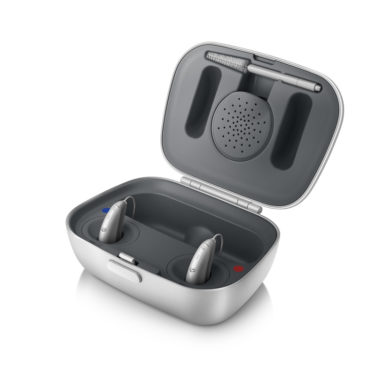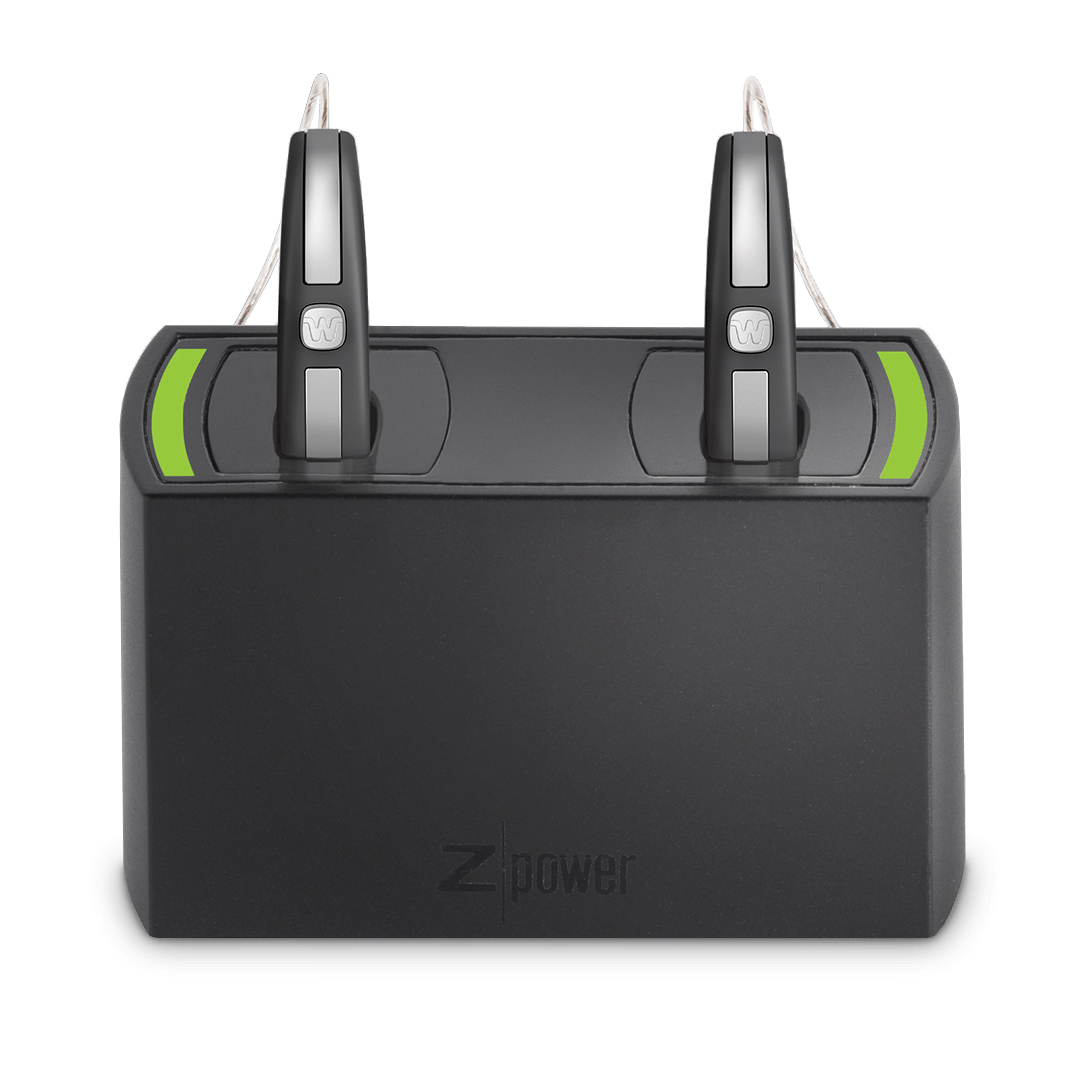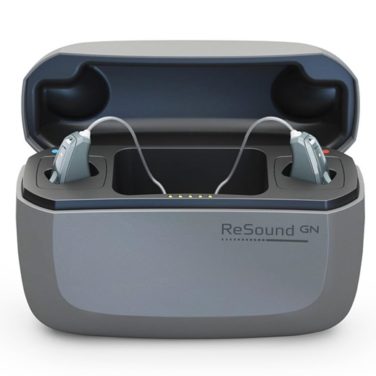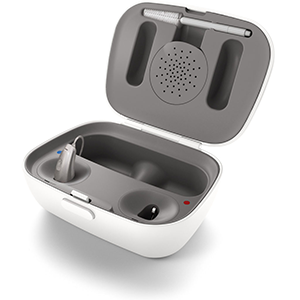The 5 Best Rechargeable Hearing Aids
There are a number of reasons why you may wish to purchase a hearing aid with a rechargeable battery option:
- Hearing aids are small, therefore the batteries that power them are small. If you have limited vision or poor dexterity (such as arthritis in your fingers), you may find changing the small batteries a challenge.
- With an overnight charge, rechargeable batteries will give you a full day of power. Just like charging your phone – put it in the charger before you go to bed and you’ll have a full power charge when you wake up in the morning. Different rechargeable batteries will vary on how long you need to charge your hearing aid (read more on this below) and how long the charge will last. Some brands will give you up to 30 hours of power.
- With a rechargeable hearing aid, you’ll have an easier device to use with less stress. Your rechargeable battery lasts a long time and, for some types, will last the life of your hearing aid.
Types of rechargeable batteries in today’s hearing aids
Lithium-ion batteries
This is the preferred option for rechargeable hearing aids and most hearing aid brands are moving to Lithium-ion technology (sometimes referred to as Li-on). They’re based on the type of batteries used in mobile phones and provide more staying power compared to other rechargeable batteries. Lithium-ion technology has a shorter charge time, longer charge in the battery before needing to recharge, and longer life-time of battery. With this type of rechargeable battery you’ll get 4 years of battery life compared to 1 year with Silver Zinc rechargeable batteries. The only drawback for Lithium-ion rechargeable batteries is that they cannot be inter-changed with a disposable battery as the Silver Zinc ones can. The hearing aid brands using the Lithium-ion option are Phonak, Signia, Starkey, ReSound, Oticon, Unitron and Hansaton
Silver Zin Batteries
This type of rechargeable battery has been made popular by the company Z Power, and can be retro-fitted to existing hearing aid brands. These batteries look like the disposable batteries you may be using in your current hearing aids. This is an advantage because if you do happen to run out of power you can slip in a disposable battery to keep your hearing aid going, until you can get to a charger. Most manufacturers are moving away from Z Power in their top-of-the line hearing aid models, however Widex have stayed with Z Power and are now using the updated Z Power system in their Evoke hearing aids.
The new Z Power system has a number of enhancements including improved charger cycle and an updated battery door to optimise battery power and life. The door is also stronger to prevent breakage and there is a greater protection against corrosion. The Z Power system comes with a dryer to ensure the battery is cleaned and dried while recharging. Silver Zinc rechargeable batteries are 100% recyclable so once the battery has run its life (usually a year) take it back to your Hearing Healthcare Provider and they will change your battery and get the old one sent off for recycling. These batteries are also non-toxic and non-flammable, but if a child or a pet swallows you’ll need to seek medical advice.
Rechargeable hearing aids available in Australia
Z Power options:
1. Widex EVOKE
Released in 2018 this hearing aid is reported as the longest lasting rechargeable battery. This is because the EVOKE has the lowest power consumption of any rechargeable hearing aid, even when streaming.
How to get the most out of your Z Power rechargeable hearing aids?
How to get the most out of your Z Power rechargeable hearing aids
If you want to get the best out of your Z Power recharger follow these steps:
- Charge your hearing aids every night. You’ll know it’s ready to use again, with full power, when the green indicator light is solid, not blinking.
- When you’re not using your hearing aids, put them back on the charger.
- Always keep some disposable batteries handy in case you forget to recharge overnight.
- If you remove the Z Power battery from your hearing aid don’t leave it near other metals as this can short-circuit the battery.
- Keep batteries and battery door clean with a soft cloth. You can use a rubbing alcohol when cleaning but don’t ever submerge in cleaning solution.
- Don’t be tempted to open and close the battery door to reboot the battery – some people do this to trick the circuitry into thinking a disposable battery has been inserted. Although your battery make work for a short time doing this can over-discharge the battery and eventually shorten the life expectancy of the Z Power battery. When you get the low battery warning either pop your hearing aids on the recharger or slot in a disposable battery until you can get to your recharger.
- If you see a red light on the charger, take your hearing aids out and check you haven’t got a disposable battery inserted. Quickly take the hearing aid off the charger and remove the disposable battery – now you can recharge your hearing aid safely.
ZPower Rechargeable Hearing Aid System from Bridge Design on Vimeo.
If your Z Power rechargeable battery is getting low on power you will hear the low battery warning in your ear (your Hearing Healthcare Professional will have gone through this in your fitting appointment). And don’t worry – you can’t over-charge your batteries if you leave them on the charger, in fact, it’s best to leave the hearing aids on the charger when not being worn, EXCEPT if you won’t be using your hearing aids for more than a fortnight. In this case, remove the rechargeable batteries from your hearing aids and store them safely away from metal objects.
Lithium-ion Options:
1. ReSound Linx Quattro
Released in 2018 with rechargeable option for RIC models only. This hearing aid provides 30 hours of battery life without streaming with 24 hours available when streaming. Three hours of charging time will give you full battery life. The charging case is the smallest on the market. Once charged, the case itself will give you three full charges for both hearing aids, making it a portable charging case – no power outlet required. The case simple to use without having to struggle matching up charging points on the hearing aid.
2. Phonak Marvel
Released in 2018 the Marvel was the first Phonak hearing aid that allowed full streaming capabilities from both Android and iPhone devices.
3. Oticon Opn S
Released in 2019 this made for iPhone hearing aid (although you can purchase the Connect Clip for an Android phone to enable Bluetooth streaming) is Oticons first lithium-ion hearing aid.
4. Unitron Discover
Released in 2019 this hearing aid allow you to stream from either iPhone or Android phones and uses soundcore technology to provide great sound quality.

5. Hansaton AQ sound SHD
Released in 2017, this RIC hearing aid will give you 24 hours of power after a three hour charge. It comes with the Comfort Charger case which has an optional desiccant capsule to keep your hearing aids dry. You can also get a Comfort Power Pack giving you up to 7 charges, without having to plug it in to a socket.





Ask an Expert
16 Responses
How much subsidy do eligible pensioners get on hearing aids? I am looking at upgrading so would be great to know so I can research brands that are in my budget. Thanks
Hi Bev, roughly $1500 subsidy.
Can you use an alternate charger with Resound Quattro?
Hi Mary, you need to use the charger that comes with the hearing aids. They are made to fit.
What aid is best between ReSound Quattro 9 the rechargeable one or the battery powered one?Thinking might get longer (Life) use out of the battery version.
Can the rechargeable batteries be replaced when they come to the end of their life cycle?
Great question, users are getting around 24 hours of use with the Rechargeable version with a little less depending on your streaming capabilities. The batteries are covered under warranty but after the warranty is over you’ll need to pay to get the replaced and send them back to Resound. They haven’t been around long enough to really test longevity yet so time will tell of their real lifespan, batteries are tried and testing and can last many years with good maintenance.
Can you use nickel-hydride rechargeable batteries in this recharging unit?
Hi Ronald, most if not all manufacturerers are now moving towards Lithium-Ion Rechargeable Batteries. They have a much higher energy density for longer lasting life.
How will the option rechargeable hearing aid effect tinnitis n both my ears?
Hi the rechargeable batteries should have no effect on your tinnitus. Hearing aids themselves can sometimes treat the symptoms but best to trial one and speak to your clinician first.
I have the OTICON OPN S – NERA2@ Pro aids but I’m looking at the WIDEX EVOKE rechargeable type would this be my best option? Thanks
Hi Tom, The Widex Evoke are great hearing aids and have amazing sound quality but they don’t have the best rechargeable option (yet). They are using the Z-Power rechargeable batteries but most manufacturers are now moving towards a lithium ion solution for longer life and better reliability.
Do inside the ear hearing aids come with a rechargeable battery facility?
Not from any of the major manufacturers at the moment. They are all using the size 10 replaceable batteries.
Where do I buy batteries for the Unitron Moxi? I have the gold rechargeable 312 batteries. I live in the USA.
Hi Rich, check E-Bay or Amazon to purchase batteries in the united states at affordable prices.